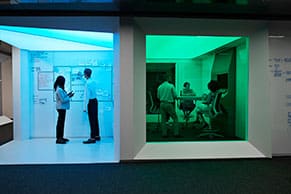Procurement teams help companies obtain the goods and services required for their day-to-day operations at competitive prices. But with supplier costs rising, talent in high demand and customers and governments expecting more sustainable and transparent supply chain processes, today’s procurement leaders are under pressure to modernize and adapt their operations in line with fast-evolving trends.
Thankfully, new trends and technologies are reshaping the procurement industry with the promise of helping businesses succeed in this challenging environment. From automation and artificial intelligence-powered procurement technologies to advanced supplier management tools and improved risk assessment strategies, this article outlines the trends that companies would be wise to monitor, as well as the best practices procurement leaders can adopt to save money and achieve their broader business goals.
What Are Procurement Trends?
The procurement industry is undergoing major shifts, trending towards strategic, responsible, and efficient processes involving sustainable practices, collaboration with suppliers, and data-driven approaches aided by the introduction of AI and automation. While a well-managed procurement operation can drive down a business’s costs, increase its profitability and boost its reputation with suppliers and customers, procurement leaders can no longer rely on the tactics of the past to succeed in today’s economy. They must continually monitor and assess the procurement process and make sure they stay on top of the latest trends to guard against any weak spots or inefficiencies.
The emergence of digital procurement technologies and supplier management platforms has raised the bar for how procurement leaders supervise their people, processes and data. Meanwhile, macroeconomic trends, including rising supply chain volatility and a growing call for businesses to invest in environmental, social and governance (ESG) initiatives, require procurement leaders to rethink their supply chain operations across the board, driving a major transformation across industries. In parallel, procurement leaders also need to ensure that their procurement practices align with best practices when it comes to data governance, ethical business operations and data security. A well-oiled procurement operation also provides a more rewarding work environment for procurement teams, which helps businesses retain their talent in a highly competitive labor market known for its high levels of churn.
Key Takeaways
- Today’s procurement priorities are being reshaped by a number of fast-emerging trends, including the digitization of procurement processes and the adoption of ESG practices.
- Procurement leaders must establish adaptable and resilient operations while continuing to optimize the cost of procuring goods and services for their business.
- A software-based approach to procurement management is integral to the success of modern procurement teams and their supply chains.
How Do Trends Impact the Procurement Process?
A business’s procurement process and priorities will vary based on the nature of its operations. For instance, a sustainable jewelry manufacturer will be uncompromising in its choice of suppliers to ensure that all the precious stones used in its products are ethically sourced — even if that means longer lead times for its customer orders. By contrast, a grocery chain will prioritize proximity and speed when choosing its suppliers to make sure its shelves are consistently stocked with the products its customers have come to expect. The scale of a company’s procurement process depends on both the goods and services it provides to customers and its broader business objectives. For example, a small local restaurant might have just one person handling the procurement of its ingredients, merchandise and equipment, while a global corporation might employ dozens of procurement professionals to manage its supplier relationships and invoicing across multiple business units and geographies.
Despite these differences, the procurement life cycle for most businesses can broadly be broken down into a few stages. In the first stage, procurement leaders define their procurement requirements, which is to say the goods and services their business needs for daily operations. With these needs defined, procurement managers will then invite suppliers to submit bids in hopes of providing the business with the goods and services in question, a process known as tendering. After evaluating the submissions, selecting their preferred suppliers and signing the necessary contracts, procurement teams will then begin sourcing deliverables from each supplier and managing their supplier relationships to ensure that they continue to receive the goods and services they need, on time and at the right price.
Every stage of the procurement life cycle will be affected by the emerging trends shaping procurement today. A company’s requirements never stop evolving, which is why procurement leaders must constantly analyze and refine the way they manage their people, processes and technology, as well as their supplier relationships, as they seek to maintain high standards of performance for their company at the lowest possible cost. Procurement managers must also keep an eye on broader industry shifts and macroeconomic trends to avoid falling behind the competition and to make sure their working practices remain compliant with the latest governance requirements.
8 Top Procurement Trends to Watch
Procurement management is a complex process that requires procurement leaders to balance the needs of their teams and their business with those of external suppliers. Today, procurement priorities are being influenced by a number of trends that offer both challenges and opportunities for procurement teams. Ranging from rapid advances in procurement software powered by artificial intelligence (AI) to the latest supplier diversification strategies, here are eight industry trends to watch.
The Rise of Digital Procurement
Companies have traditionally tracked and managed their procurement processes manually, documenting details on spreadsheets and communicating via phone calls and email. But procurement management has many moving parts, ranging from supplier sourcing to financial reconciliation, and manual methods are proving to be more time- and labor-intensive than many procurement teams can afford. Manual procurement processes are also prone to human error, especially in growing businesses that must juggle an increasingly large and dispersed supply chain network.
New digital procurement technologies are helping companies overcome these challenges to make procurement teams more agile, efficient and scalable while also improving regulatory compliance. With all financial, operational and supplier data now accessible on a single digital platform, procurement leaders can make informed decisions based on real-time views of their deliverables, timelines, supplier relationships and more. Real-time visibility into their finances equips procurement leaders to better track their spending and ensure that they meet budgetary targets.
Digital solutions also eliminate procurement bottlenecks caused by slow manual processes that often lead to a buildup of unnecessary costs and disruptions across the procurement workflow. The elimination of bottlenecks also helps procurement teams maintain healthy relationships with their suppliers by making sure that all invoicing and payments are handled efficiently and accurately. As for compliance, digital procurement processes create a clear, centralized audit trail. In addition to allowing procurement leaders to track and address regulatory risks across their workflows, a clear and automated audit trail reduces the chances of noncompliance caused by human error.
Many organizations choose to digitize their procurement processes as part of a wider enterprise resource planning (ERP) system implementation. By running their procurement processes on an ERP system, businesses can track data related to their procurement workflows as well as crucial data from other business functions, including accounting, inventory management, human resources, logistics and supplier relationship management — all in a single location. The procurement module within an ERP system automates important steps of the procurement process, such as supplier evaluations and invoicing.
Advancements in AI and Automation
While technology cannot replace the critical thinking capabilities of a seasoned procurement professional, advances in automation and AI promise to make procurement workflows more time- and cost-efficient by orders of magnitude, not to mention more accurate. By combining automation and AI technologies in their processes, procurement teams can expect to improve the speed at which they generate actionable insights, as well as the quality of their predictive modeling, anomaly detection and risk management. With so much to gain, the global market for AI in supply chain management (SCM) is expected to reach over $83 billion by 2028.
The rise of generative AI, in particular, is expected to transform the way procurement teams will operate in the coming years. Unlike early AI and machine learning algorithms, which are designed to analyze and make accurate predictions about the future based on large and complex datasets, generative AI models can create original content and ideas in response to simple text prompts. For instance, a procurement manager who needs to evaluate bids from multiple suppliers might ask generative AI software to scan through the bids and categorize them in order of cost, risk exposure and relevance to their business goals, cutting hours from the evaluation process. Indeed, research from McKinsey predicts that generative AI will help procurement teams find new suppliers for their business in a matter of days, rather than months.
Sustainable Procurement Practices
Businesses across every industry increasingly recognize the importance of environmentally conscious and sustainable procurement practices. The top sustainability goals among companies and their procurement teams include the reduction of carbon emissions, a more responsible approach to sourcing and supplier selection, and the reduction of waste across procurement workflows. Sustainability initiatives in procurement are also being driven by consumers, who grow more environmentally conscious every day and expect greater transparency into the provenance of the goods they buy. For example, it’s estimated that in the U.K. more than 60% of consumer spending on fast-moving consumer goods, such as packaged foods, toiletries, cosmetics and over-the-counter drugs, will come from eco-conscious shoppers.
Governments and regulators are on board as well, particularly when it comes to reducing carbon emissions. The U.S. government is leading by example in this regard with its Federal Sustainability Plan, announced in late 2023. The executive order outlines rules and regulations that will help the government achieve net-zero emissions for all federal procurement by 2050.
Crucially for procurement leaders, investments in sustainability promise to make their supply chain operations more cost-efficient and resilient. For instance, tactics like nearshoring, which involves keeping as many procurement processes as possible close to home, not only reduce carbon emissions but also make businesses less dependent on international suppliers and trade agreements and less susceptible to freight pressures. Similarly, by making their procurement workflows and supply chain processes more energy efficient, companies can lower their utility bills, which, in turn, drives down their overhead costs.
One major challenge for procurement leaders is how to build a reliable network of suppliers that are as committed to sustainable business practices as they are. According to Amazon’s 2024 State of Procurement Data Report, 85% of procurement teams cite the difficulty of sourcing sustainable suppliers as a barrier to setting or achieving their sustainability goals.
Enhanced Risk Management Strategies
The ability to proactively identify and mitigate risk is essential for procurement teams. Faced with an uncertain geopolitical landscape, an ever-changing mix of suppliers and the growing threat of attacks from cybercriminals, procurement leaders must be able to quickly flag, address and manage these issues to minimize any disruption to their company’s procurement operations.
In addition to proactive risk management, procurement leaders must develop robust contingency plans so they can pivot in response to fast-changing situations and continue to operate at full capacity. For example, an American toy manufacturer that procures most of its parts from a Japanese supplier might choose to source more of its parts from a local supplier during Japan’s typhoon season, when frequent storms could delay overseas shipments.
A key component of risk management for procurement teams is supply chain mapping — i.e., the process of visualizing the flow of materials, data and payments across the supply chain in order to understand the relationships among all these moving parts. Supply chain mapping provides procurement teams with the insights they need to analyze their operations at a granular level, complete risk assessments and conduct scenario-planning studies that will help them develop risk mitigation strategies.
Effective risk management for procurement leaders also comes down to team awareness of risk and an appreciation for the importance of supply chain resilience. By fostering a risk-aware culture and dedicating resources to supply chain resilience projects, procurement leaders can ensure that risk mitigation remains front of mind for their employees and that this mindfulness translates into how they handle everyday procurement processes, from the sourcing of raw materials to supplier management and invoicing.
Supplier Development and Growth
Good supplier relationships drive good procurement practices. Whether it’s better prices, improved planning or greater agility in the face of adverse events, a procurement team’s ability to build and maintain strong relationships with a diverse network of reliable suppliers is fundamental to its success.
The process of systematically tracking, evaluating and optimizing these relationships is known as supplier relationship management (SRM). The aim of SRM is to determine what, if any, changes can be made to a business’s supplier network to improve the efficiency of its procurement processes and make sure they align with the company’s broader business goals. Procurement teams can achieve this by monitoring supplier-focused key performance indicators (KPIs) that reveal whether their supplier strategies are delivering the necessary speed, quality and reliability at the best possible cost. These KPIs include:
- Supplier lead time: The average number of days it takes for suppliers to deliver items after receiving a purchase order.
- Supplier defect rate: The proportion of defective parts in a supplier’s shipment relative to the total number of parts delivered.
- Supplier availability: A supplier’s ability to deliver on last-minute procurement requests or urgent demands.
The relationships a procurement team has with its suppliers aren’t one-sided. Procurement leaders increasingly appreciate the value of collaborating with their vendors and building loyalty among their most trusted partners. Real-time collaboration has become more important in a fast-paced world where geopolitical events or a global pandemic can derail even the best-planned supply chain strategies and force procurement teams to adapt overnight in the hope that their suppliers can pivot just as quickly to accommodate their needs.
It’s also worth noting the value of loyalty in fostering win-win supplier relationships. Just as procurement teams are drawn to fast, trustworthy vendors, suppliers prefer to work with reliable businesses that provide them with a steady stream of orders — and payments. These close relationships can prove especially valuable in the face of disruptive events that limit the supply of certain goods and raw materials that are crucial to a business’s operations.
Training and Upskilling
Hiring procurement professionals is one of the biggest challenges for procurement teams. According to Gartner, just 14% of procurement leaders say they have the talent they need to meet their future goals. Finding qualified people will only become more difficult as the procurement talent pool shrinks, with the World Economic Forum predicting a churn rate of 25% in the supply chain and transportation sectors.
To combat the instability caused by today’s talent shortage and high churn rate, procurement leaders must focus on upskilling their employees to ensure that their skill sets align with the business’s needs. Upskilling is especially important for procurement teams that are replacing manual processes with digital procurement solutions that require employees to master these new technologies to unlock their full potential.
Consider a chief procurement officer (CPO) whose company is implementing a new ERP system to integrate its supply chain operations, including procurement processes like supplier management and invoicing. To ensure a successful implementation, the CPO will need to invest in training the procurement team to transition from manual processes to the ERP system so they can take advantage of the automation and efficiency gains the technology promises to deliver.
In addition to training procurement talent to perform at a high level, leaders can encourage retention by investing in their employees’ career development. Education, career progression and salary increases that match or exceed industry benchmarks all go a long way toward driving job satisfaction and loyalty, helping businesses to retain their valued employees rather than losing them to the competition.
Procurement Diversification Strategies
One of the most important lessons procurement leaders have learned in recent years is the importance of diversifying their procurement strategies. Faced with unpredictable geopolitical conditions, volatile shipping and commodity markets and the increased frequency of major weather events, businesses must be able to react to change quickly, without disrupting their procurement operations.
In practice, this means diversifying procurement channels across multiple suppliers and countries, the latter in the case of procurement teams that source goods from overseas. By diversifying their supplier bases in this way, procurement leaders can minimize the possibility that their operations will screech to a halt in the case of an unpredictable event, be it government sanctions that drive up the cost of international shipments or a major weather disturbance that forces suppliers in a given region to temporarily suspend shipments.
In some cases, diversification requires businesses to revisit or allow for variation in the raw materials used to produce their goods and services. For instance, an international confectionary brand might source its sugar from domestic vendors in each country where it operates to maintain a steady supply of this vital ingredient at the local level, while also reducing procurement costs across its global operation.
The digitization and automation of procurement processes can also help procurement leaders manage a larger and more diverse supplier network. For example, automated supplier evaluation and selection processes ensure that procurement teams always work with the most qualified and cost-effective suppliers available, without requiring them to spend hours conducting these studies themselves.
Focus on Environmental, Social and Governance (ESG) Factors
ESG investment is an investing principle that prioritizes ethical business operations. The aim of ESG investment is for companies to be more mindful of the way they pursue business objectives, such as growth and revenue, so that they simultaneously address the ESG concerns of today’s society. For a procurement team, ESG goals might include the reduction of greenhouse gas emissions in their supply chain processes or a commitment to work only with suppliers that respect fair labor standards in their treatment of employees.
Environmental sustainability will be the emphasis for ESG-focused procurement teams in the immediate future, especially with governments around the world setting ambitious targets for businesses to reduce their carbon emissions. According to the United Nations, more than 140 countries have set targets to achieve net-zero in the coming decades, which means they’ve committed to reducing their emissions to a small residual amount that can be absorbed by the natural environment while leaving zero emissions in the earth’s atmosphere. In aggregate, these countries account for 88% of the world’s total emissions.
Procurement teams play an integral role in ESG initiatives. According to McKinsey, between 80% and 90% of greenhouse gas emissions are considered Scope 3, which refers to indirect emissions generated across a company’s value chain and include those embedded in purchased goods and services. The challenge for procurement leaders will be to uncover where these Scope 3 emissions are being generated in their supply chain and find ways to bring this figure down. ESG tactics will vary based on the nature and scale of each company’s procurement operations. That said, every solution will involve a combination of more efficient supply chain processes and technologies, improved transparency into the provenance and shipping methods used to transport raw materials, and a greater focus on ethical business practices.
Best Practices for Adapting to Emerging Procurement Trends
New procurement trends emerge each year. The goal for procurement leaders isn’t just to adapt to the realities of today’s market but to modernize their operations, so they can stay one step ahead of new trends as they develop. For an overwhelming majority of procurement teams, this means investing in digital technologies, such as analytics, automation and AI, and upskilling their talent to effectively leverage these digital procurement solutions. Best practices to follow to achieve these goals include:
Assess Organizational Readiness
The first step in any transformation project is to evaluate where the organization stands today and what it must change to achieve its future goals. To assess organizational readiness, procurement leaders must analyze their current people, processes and technology and assess how well they align with their team’s objectives with regard to cost, efficiency, governance, innovation and talent.
Some procurement leaders choose to conduct an organizational readiness assessment before adopting new ways of working or implementing new technologies. In addition to helping them understand whether they’re prepared to proceed with these projects, these assessments provide leaders with a complete and realistic grasp of their requirements so they can map out a clear transformation plan. Below are the key factors procurement teams should evaluate to assess their organizational readiness.
- Executive buy-in and alignment: Digital transformation projects in procurement rarely occur in silos. To ensure a successful modernization effort, procurement leaders must get buy-in from fellow leaders across their company’s supply chain organization, from accounting and finance teams to warehouse managers. This is especially important for businesses looking to implement an integrated ERP system that links all these departments together.
- Operations: Transforming a procurement team’s operations is a major undertaking, especially for companies that need to redesign their processes from the inside out to prioritize ESG principles. A realistic assessment of where procurement operations stand today will help procurement leaders identify areas for improvement and set realistic timelines for these changes.
- Data and analytics: Sound data practices breed sound decision-making for procurement teams, but businesses that still collect and manage their procurement data manually face an uphill battle in migrating this data and digitizing their analytics processes. For many organizations, this is one of the longest and most demanding components of a digital transformation.
- People and skills: To adapt to emerging trends, procurement teams need the knowledge, mindset and skills to capitalize on novel opportunities and tackle new challenges as they arise. By assessing the team’s current capabilities, a procurement leader can identify gaps and lay out a strategy to upskill employees accordingly or hire qualified talent where necessary. For example, a manufacturing company’s procurement team might have the manpower to implement a new AI-powered supplier management solution but require outside expertise to lead its employees through the implementation.
- Technology: Emerging procurement trends require procurement teams to integrate digital technologies into their daily workflows. Levels of digital maturity vary significantly among different procurement teams, depending on the size, scale and legacy of their organization. For instance, some may have been using software to handle their order management and supplier relationships for years, while others may be exploring these technologies for the first time. The aim for procurement leaders will, therefore, be to establish their organization’s level of digital maturity today and set a path toward reaching the desired future state.
Invest in Technology and Training
By investing in the most suitable procurement technologies and training employees to leverage these solutions, procurement leaders can fortify their operations despite the specter of constant change. The ability to collect, integrate and analyze procurement data quickly and accurately stands out as a top priority across industries, with Allied Market Research projecting that the procurement analytics market will be worth over $32 billion by 2031.
Many procurement teams are building on their data analytics capabilities with predictive analytics solutions that allow them to make data-driven predictions about the future and optimize their strategies in line with these predictions. Accurate forecasts will become increasingly important for procurement leaders, helping them to adopt data-driven strategies that make their operations more time-, energy- and cost-efficient. Consider an electronics company that sources copper for its devices from multiple suppliers around the world. To better manage its costs, the company can use predictive analytics to analyze historical data on copper’s market value alongside its own history of supplier invoices, which will, in turn, help decision-makers determine the best time to procure copper in the future, and from which supplier.
Cloud-based SCM solutions are also gaining traction among procurement stakeholders, who require greater visibility across the supply chain to identify cost-cutting opportunities and reduce their emissions in line with ESG objectives. By combining a cloud-based approach to data and supply chain management with the decision-making capabilities of AI, procurement teams stand to accelerate their operations and become more agile, helping them to navigate emerging trends at pace.
Develop a Trends-Based Strategy
By developing and implementing trends-based procurement strategies, procurement leaders can make their teams and processes more future-friendly. Common investment areas include advanced market research; new technologies, such as digital procurement solutions and AI-powered procurement technologies; and upskilling talent to keep up with the latest procurement trends. Procurement leaders should also consider the challenges presented by top procurement trends, such as government pressure to hit net-zero targets in the coming decades and the growing risk of cybercrime.
To promote the adoption of trends-based procurement strategies across their teams, CPOs can set up centers of excellence to develop their talent accordingly, which will then empower employees to adapt to new procurement trends, rather than falling behind and compromising the business’s performance. A trends-based procurement strategy also reflects mindset. To manage high levels of volatility in today’s world, procurement employees need to understand how their business and suppliers respond to macroeconomic levers, such as rising interest rates and commodity prices, or to swings in consumer confidence. Once again, scenario planning has a significant role to play in helping procurement teams prepare for multiple eventualities, be they the temporary cooling of inflationary pressures or the enactment of new Scope 3 emissions regulations.
Navigate Procurement Trends With NetSuite
To navigate the factors shaping procurement, businesses need complete visibility and control over the people, processes and systems that underpin their procurement operations. NetSuite ERP integrates data and resources across the modern supply chain, giving procurement stakeholders access to vital information to inform their decision-making. In turn, data-driven decision-making drives process efficiency, improved supplier relationships and lower procurement costs.
NetSuite Procurement, part of NetSuite ERP, centralizes the entire procurement process from supplier management and invoicing to recordkeeping. With a real-time view of their spending and supplier performance shown in a clear, dashboard format, procurement leaders can identify cost-cutting opportunities and work more closely with their vendors to drive strategic initiatives, such as carbon-emission reductions. Together, these benefits ensure that procurement teams continue to buy the goods and services they need when they need them and at the best possible price, while meeting their broader business goals.
Procurement leaders have always faced significant pressure to optimize their operations and drive down costs. Today, their job has become even more challenging, thanks to the trends that are reshaping the way businesses procure goods and services and manage their suppliers. Whether their goal is to implement advanced automation and AI software, make their procurement operations more sustainable, or reduce churn and upskill their talent, procurement teams that want to succeed in today’s environment must build adaptability and resilience into their operations. For many, a digital approach to procurement, powered by a centralized software platform, will be the unifying force that makes this transformation possible.
#1 Cloud ERP
Software
Procurement Trends FAQs
What is the future of procurement?
Procurement will only become more important for businesses, as supply chains become more diverse and complex and as geopolitical conditions become less predictable. In addition to helping organizations keep their costs in check, optimized procurement processes are directly linked to the success of environmental, social and governance initiatives, which are a key investment area for future-focused companies.
What is the biggest challenge facing procurement today?
Procurement leaders face many challenges that threaten to derail their operations and drive up the cost of procuring goods and services for their businesses. These include rising inflation and supply chain costs, volatile market conditions and geopolitical relationships, and a shortage of qualified procurement talent. The ultimate challenge for procurement teams is how to tackle all these issues while continuing to modernize their operations and deliver on their business’s broader strategic objectives.
What is the priority of procurement going forward?
Procurement leaders will need to balance multiple priorities at once to succeed, but the top goal for future-focused procurement teams is to digitize their operations to make them more efficient and resilient. Where manual procurement processes are time-intensive and prone to human error, digital procurement software allows procurement teams to centralize and automate critical processes, such as supplier evaluations and invoicing, accelerating procurement by orders of magnitude without driving up operating costs. To leverage digital solutions and reach their full potential, procurement leaders must also train and upskill their staff to use these technologies in their daily workflows.









